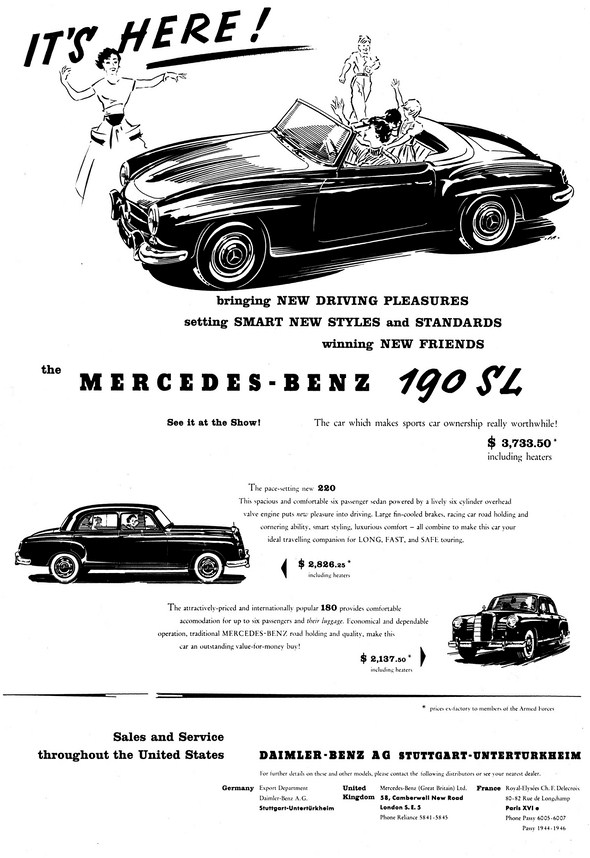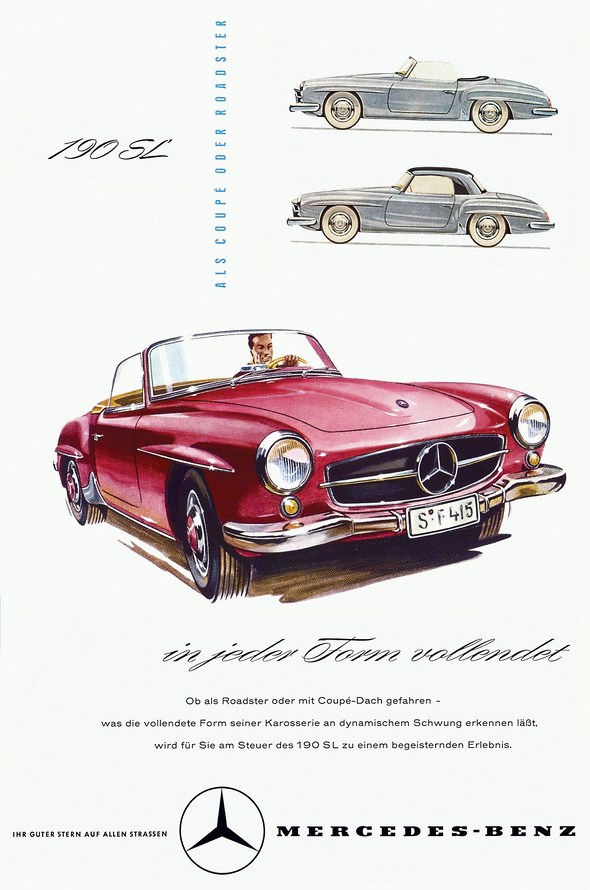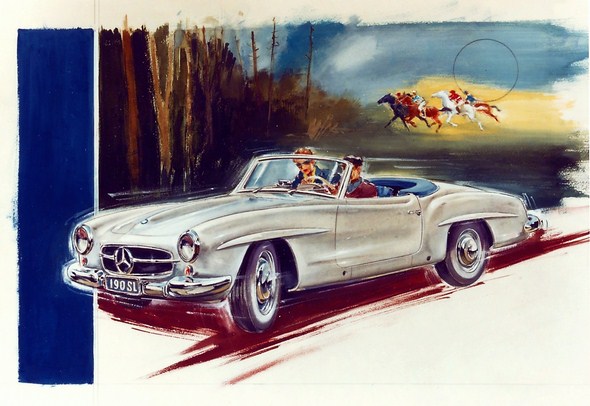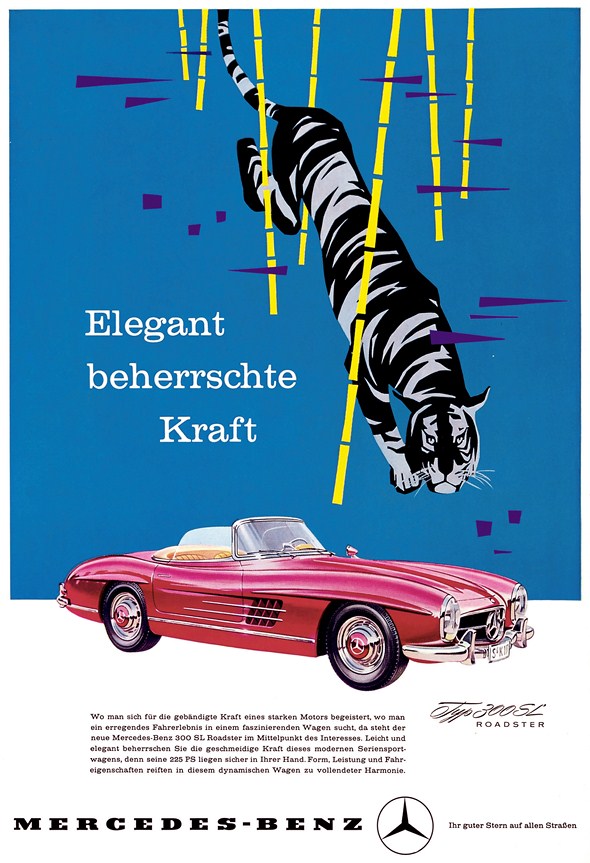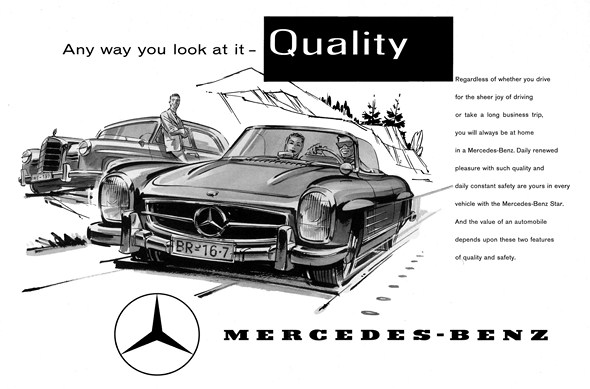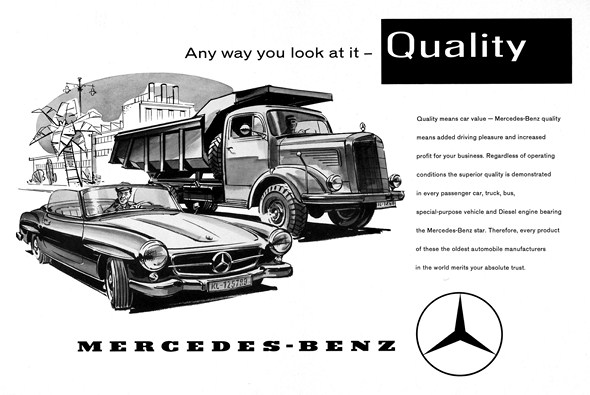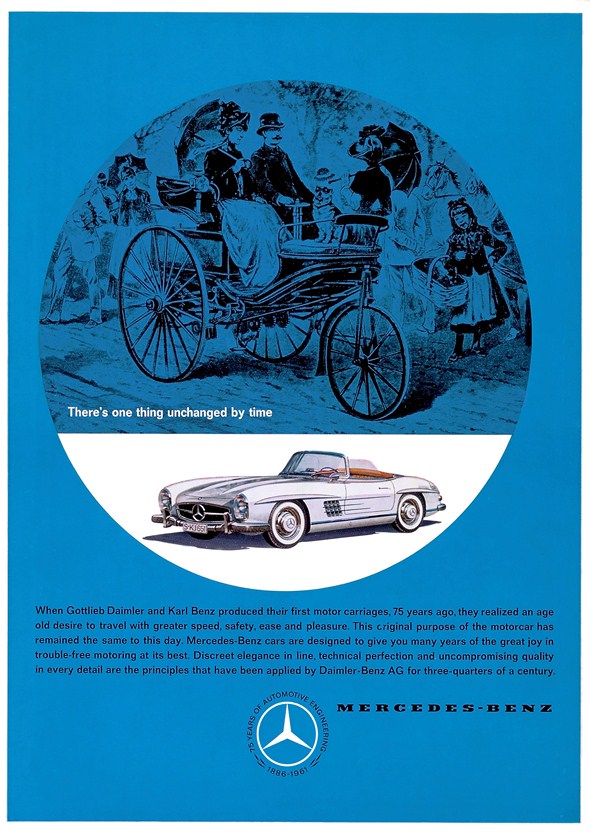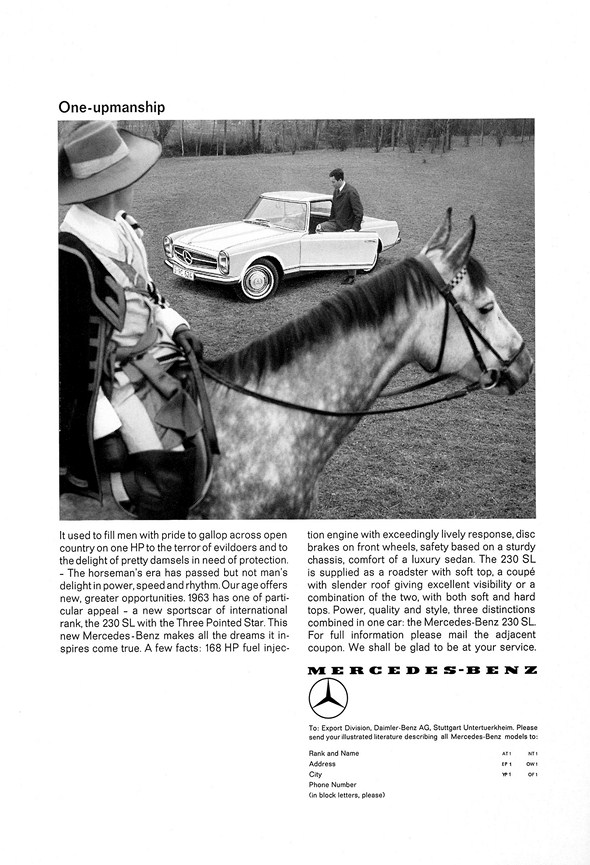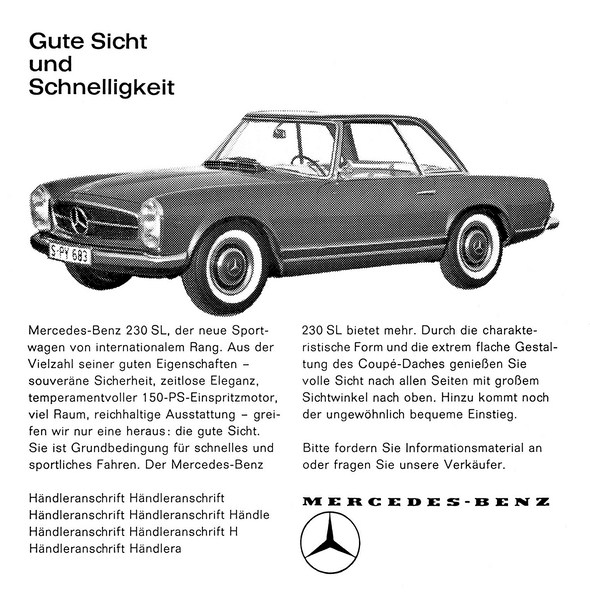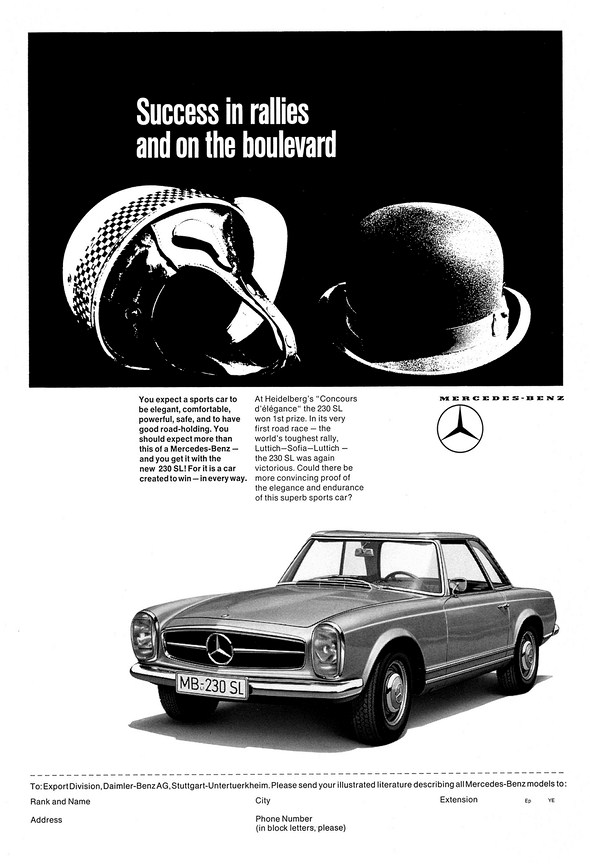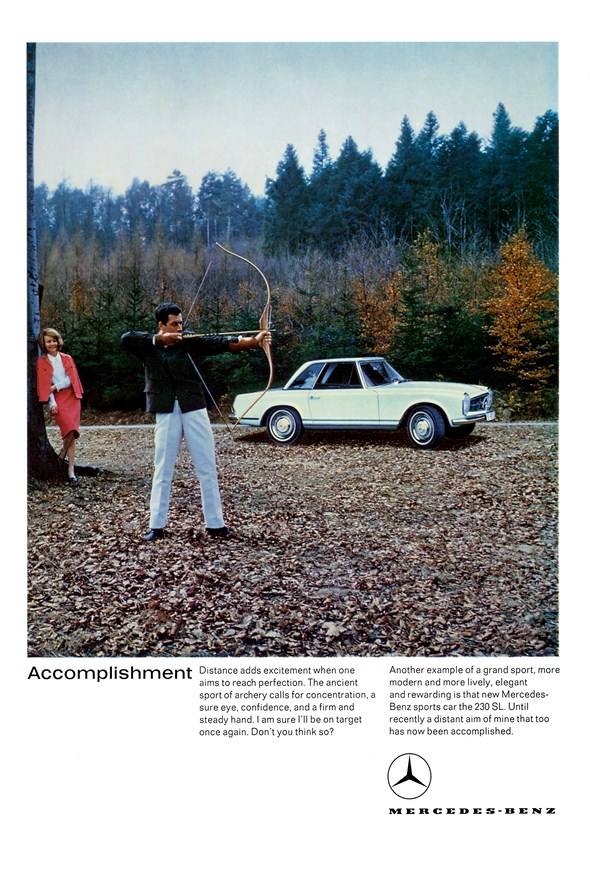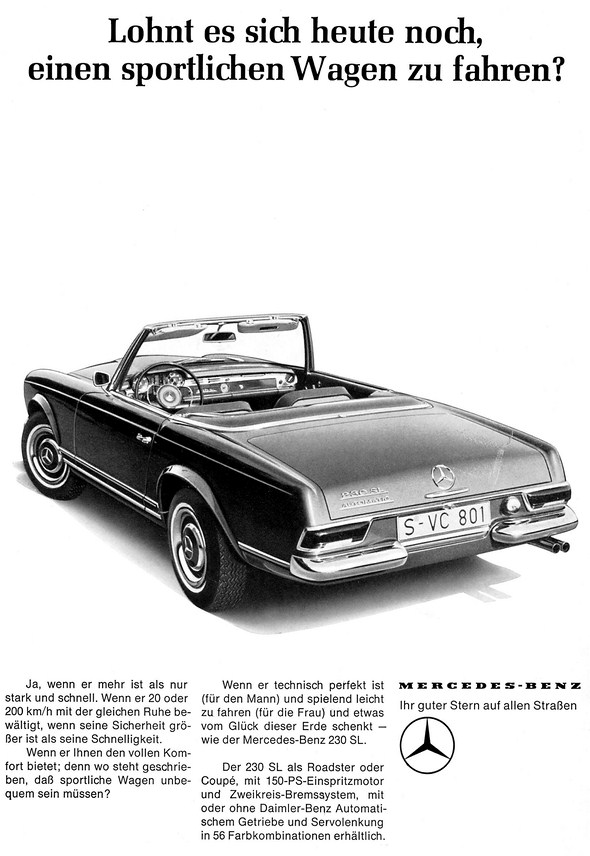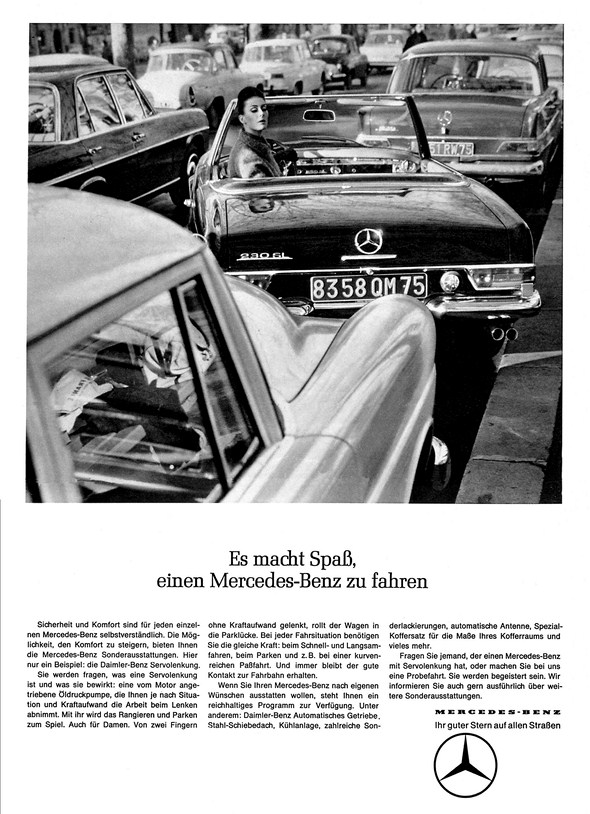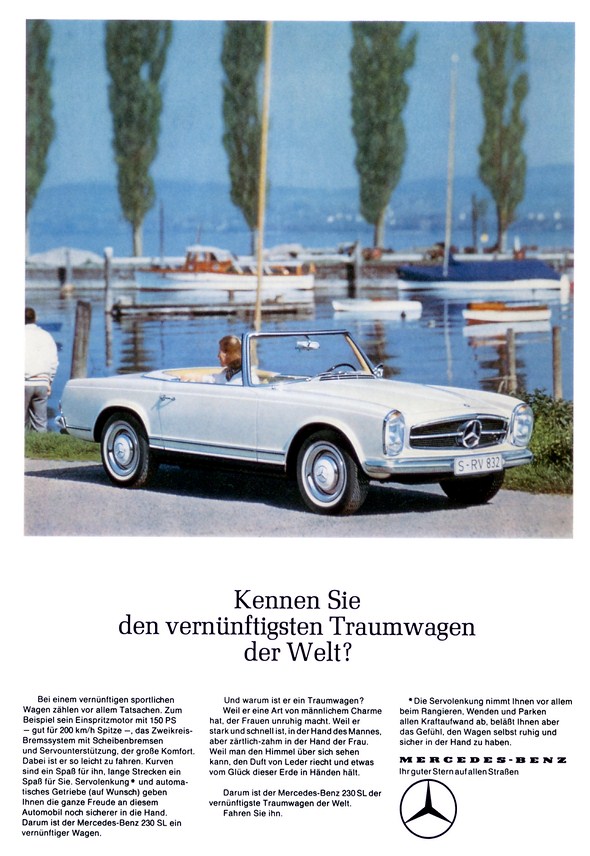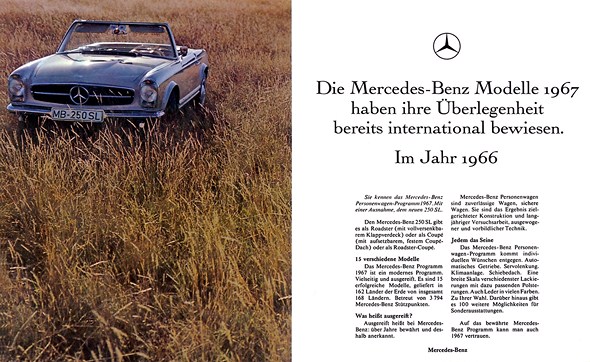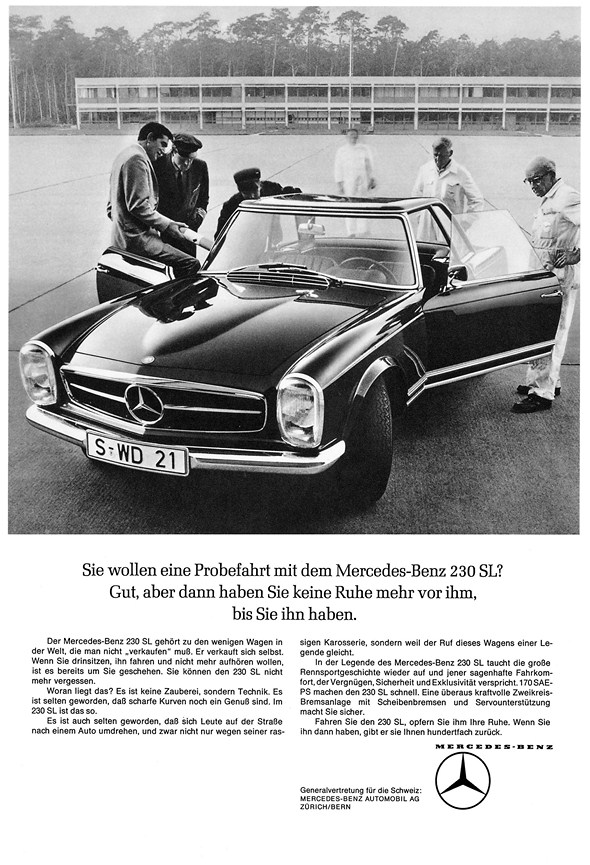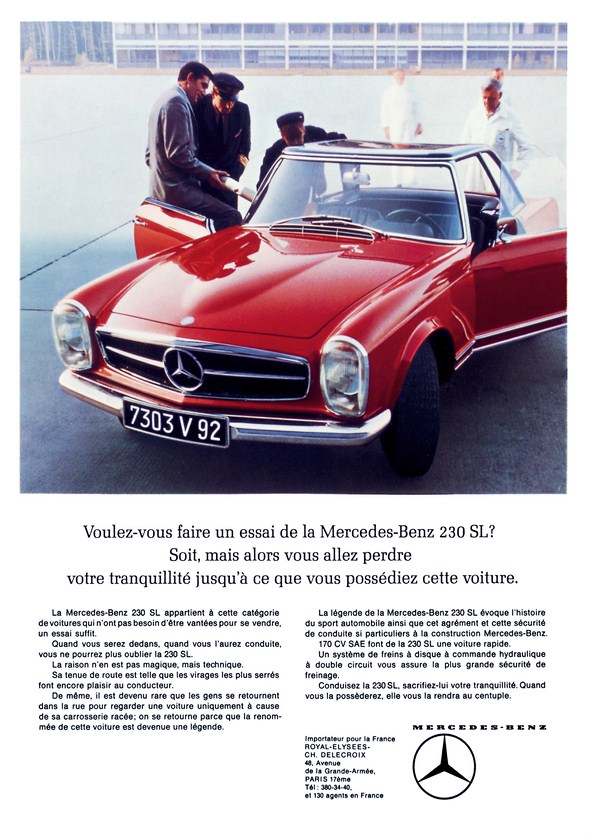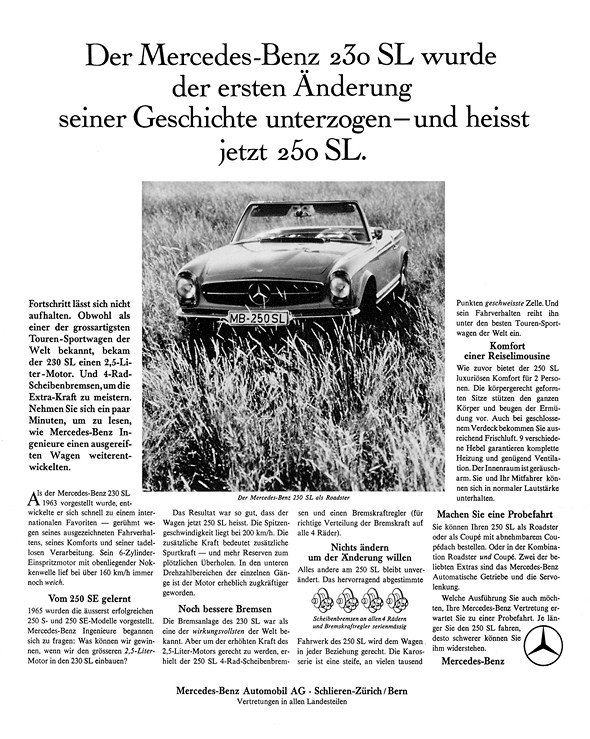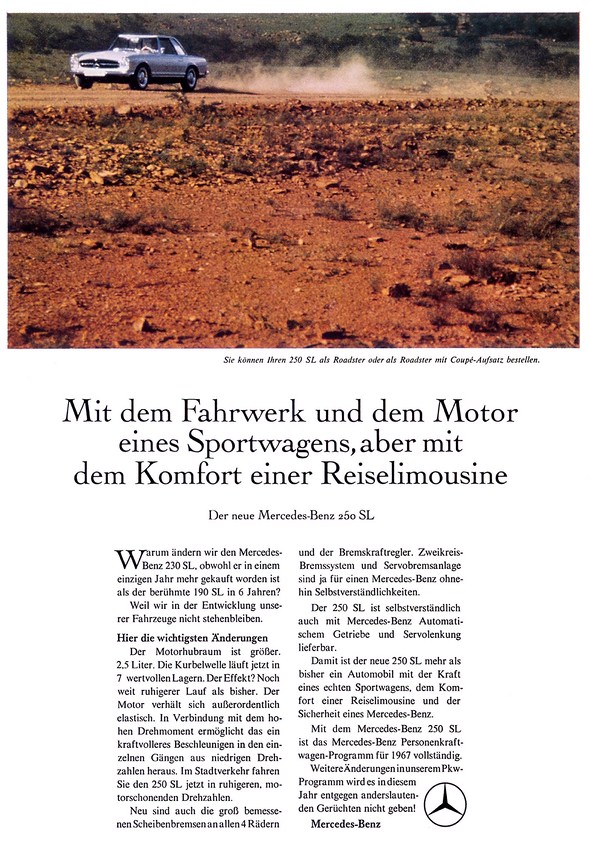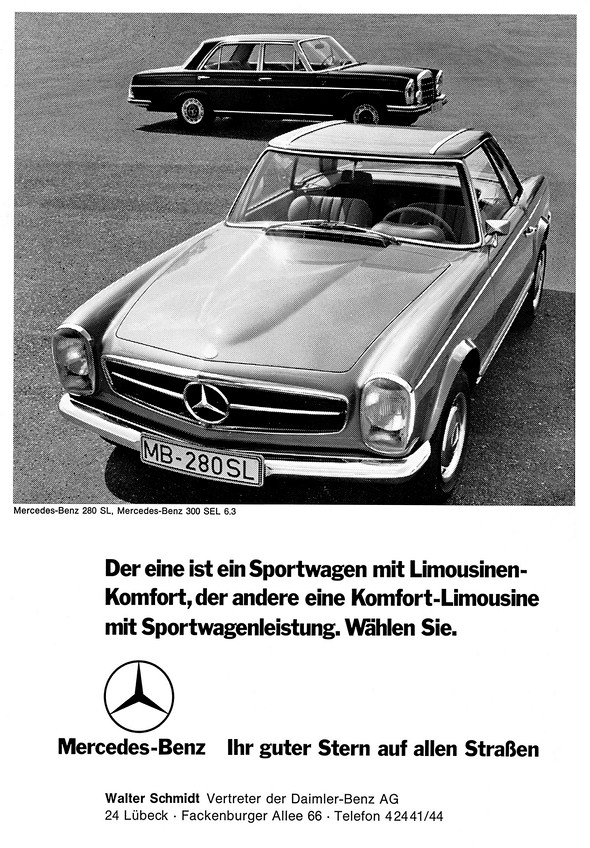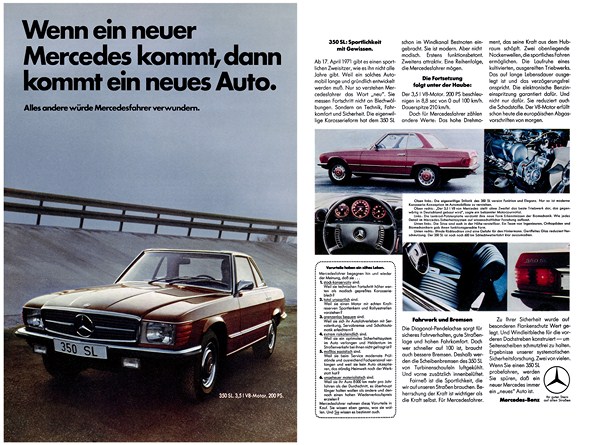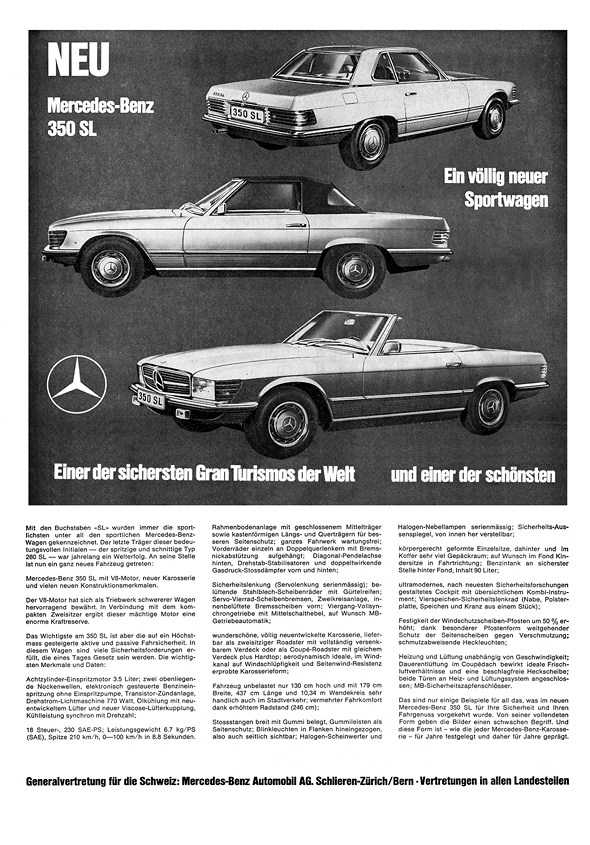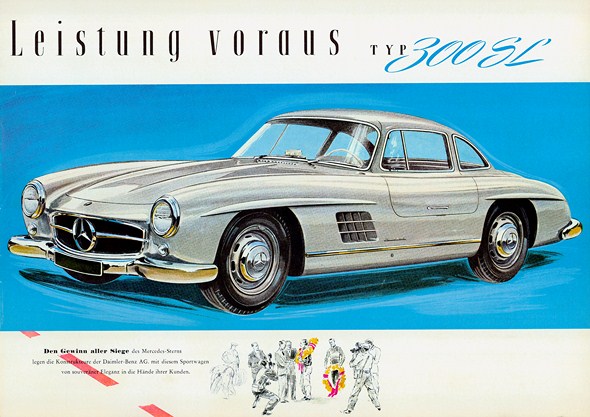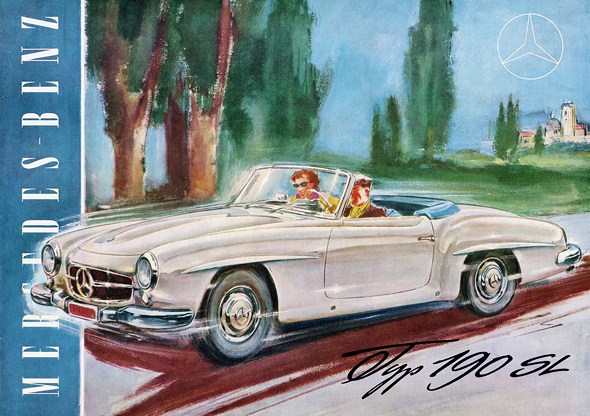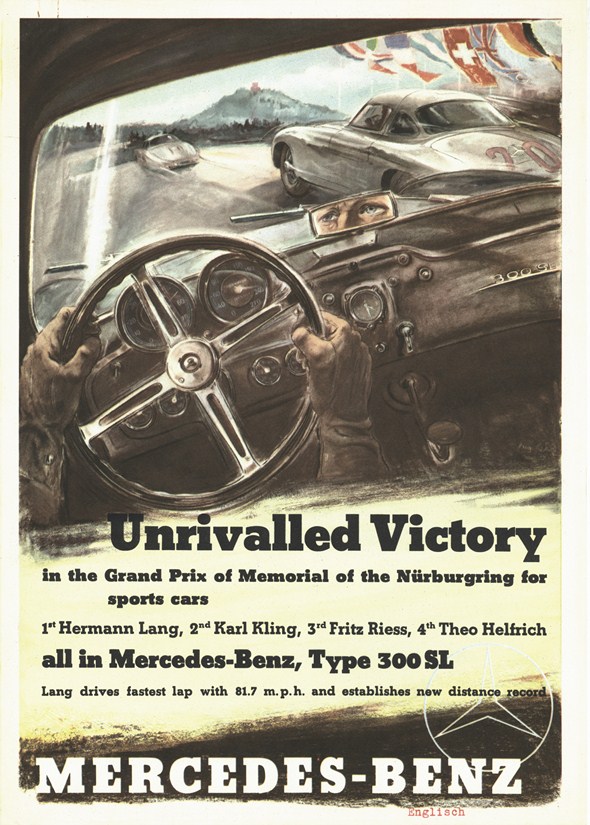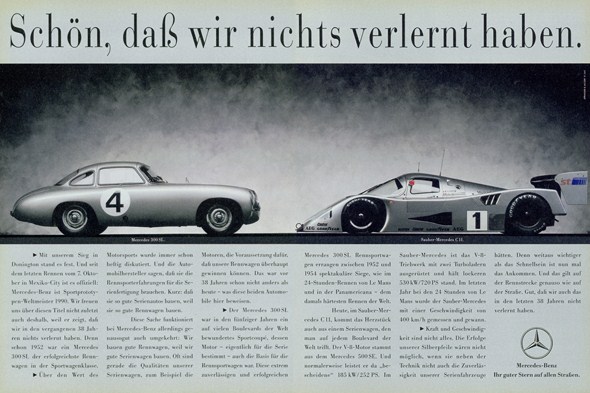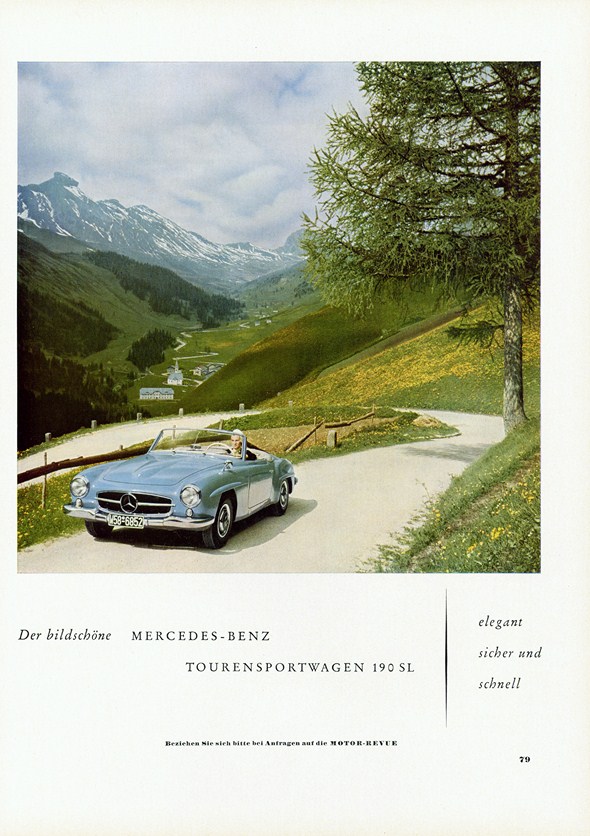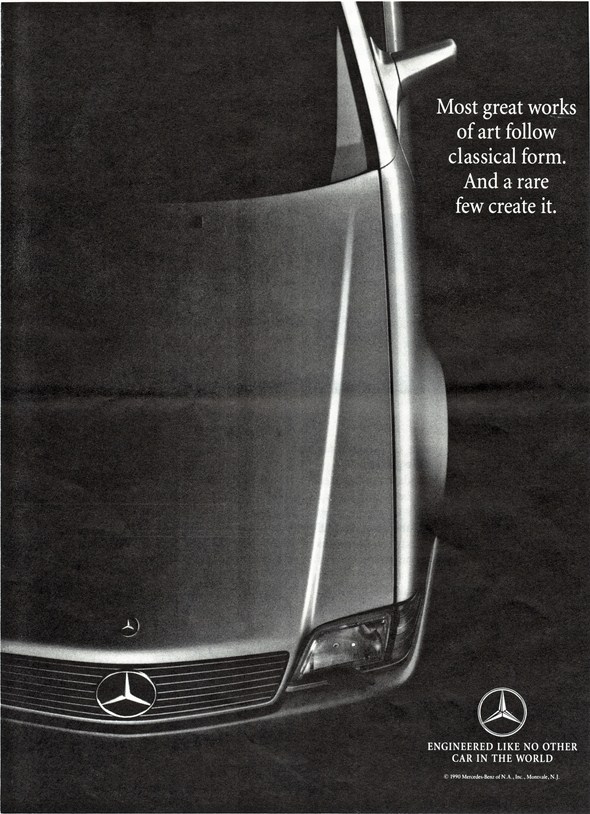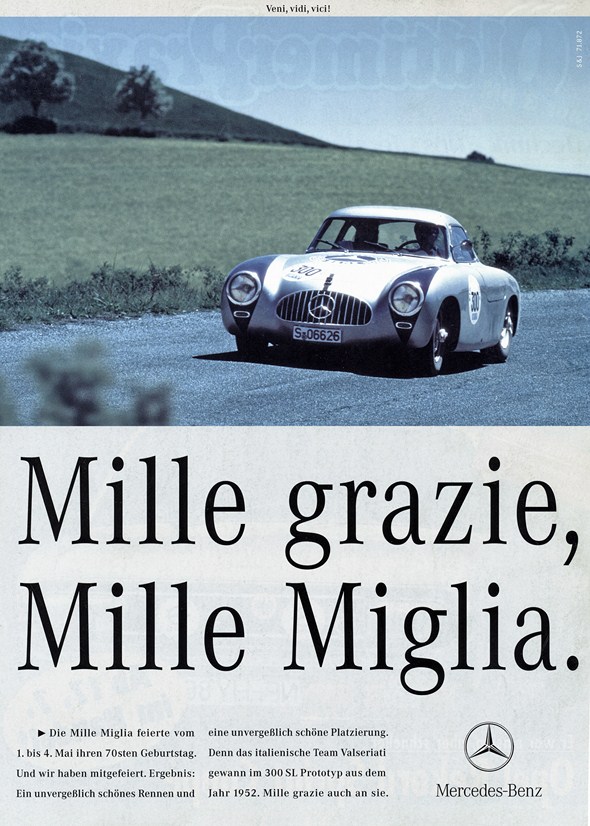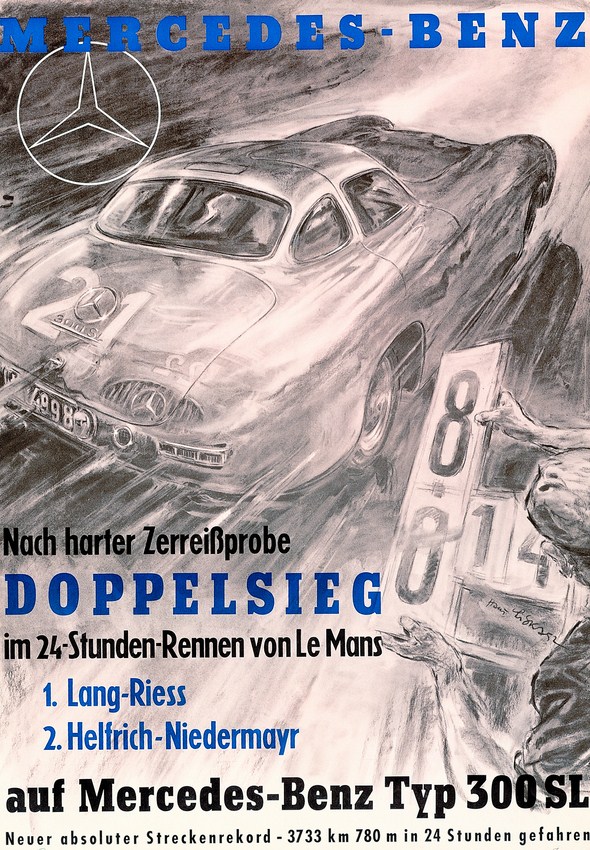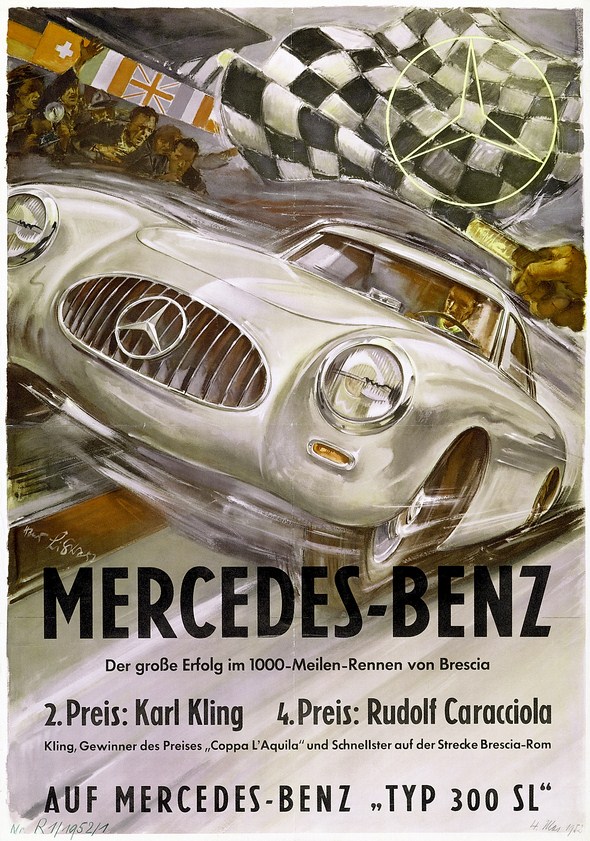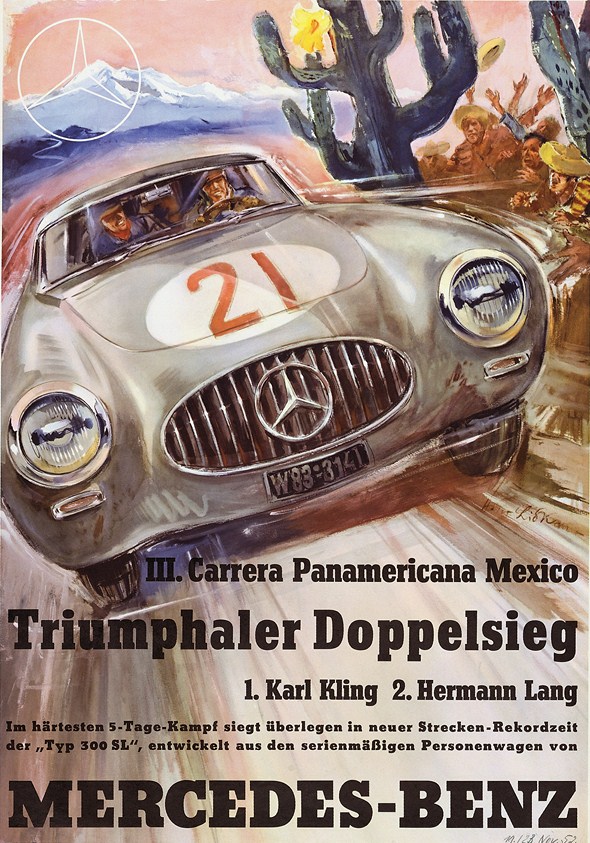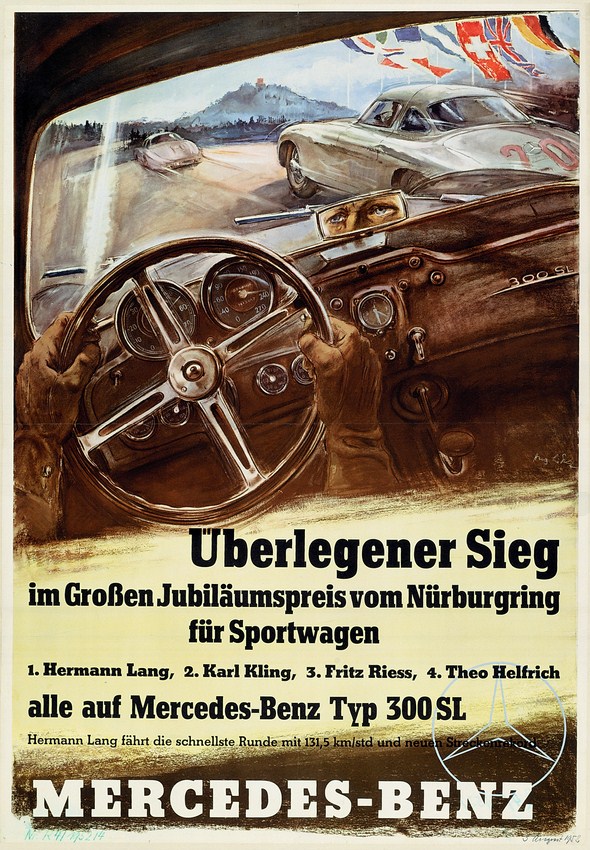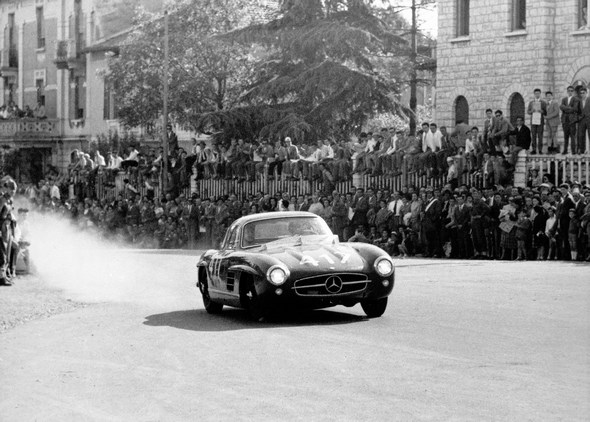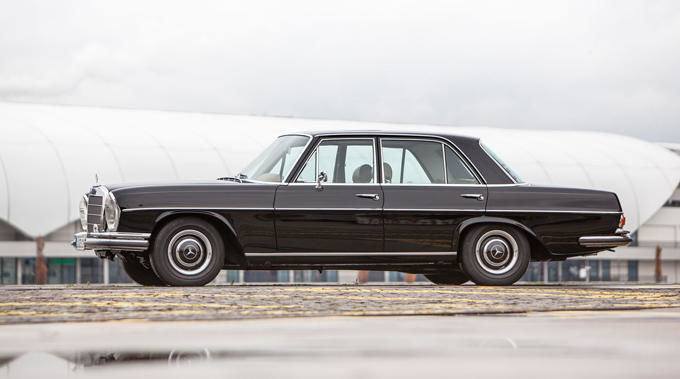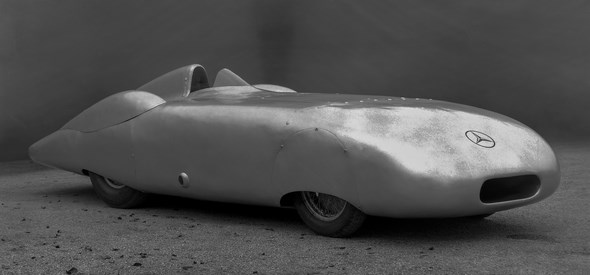Mercedes-Benz SL in advertising: product ranges as icons of their time


- A unique advertising history relays the story of unique vehicles
- Advertising motifs, photos and illustrations from 1952 to the present day
Stuttgart – The Mercedes-Benz SL product range is legendary. The world premiere of the latest SL from the R 231 model series at the Detroit Auto Show in January 2012 showed impressively just how alive this legend still is. One could think that the SL is an icon which really needs no advertising of any kind.
On taking a closer look, however, it becomes clear that the publicity agencies employed by Mercedes-Benz have been extremely skilful at making the most of the aura surrounding the SL – and have been doing so ever since 1952.
Again and again the product range – known simply as the SL – turns up in advertising, making car enthusiasts’ hearts beat faster. It all started way back in 1952 with various advertising efforts in connection with the 300 SL racing sports car (W 194), the founder of the SL dynasty. Artistically painted posters from all over the world depicting racing victories do not just pay tribute to the heroes behind the wheel, but also show the technical superiority of the Mercedes-Benz sports car.
The 300 SL racing sports car proved its strength on international racetracks partly using technical features used in cars from the Mercedes-Benz series production line at the time.
The international success of the series production racing car with its famous gull wing doors introduced in 1954 under the name 300 SL (W 198) was prepared well in advance. Although the posters were generally preferred for showroom use, the 300 SL started to appear more and more frequently in newspapers and magazines as a symbol for the brand with the star.
Other companies in the automotive branch jumped on the bandwagon and used this fascinating vehicle as an advertising medium for their own products.
The effect of the still pictures used in advertising was surpassed by the new vistas opened up by the rapidly expanding use of moving pictures. Shots of the SL driving at breakneck speeds flickered across cinema screens and, from the 1960s on, they even brought a feel for speed to viewers at home in their own living rooms.
Many people dreamed of owning a car like the Mercedes-Benz 230 SL (W 113) and in 1966 the advertisers titled it without further ado as the “most sensible dream car in the world”. Almost 30 years later, in 1991, the 300 SL (R 129) was presented as “A summer night’s dream”.
And from one generation to the next, one thing has not altered: since 1952, the SL has found its place in advertising as a fascinating car which uniquely succeeds in combining sportiness with comfort as well as breathtaking design with innovative engineering.
The early years: 1952 to 1963
- 300 SL (W 194) racing sports car drives home triumphal victories thanks to technology transfer
- Standard production vehicles 300 SL, 190 SL and 300 SL Roadster are icons in the history of advertising
The striking radiator grill with its large star is projected across the whole poster and at the side of the track enthusiastic spectators are throwing their Mexican straw hats up into the air, whilst in the background an oversized cactus is growing skywards.
Portrayed sitting in the cockpit of the Mercedes-Benz 300 SL racing sports car are Karl Kling and co-driver Hans Klenk, the two heroes of the 3rd Carrera Panamericana through Mexico in 1952 – one of the most challenging road races in the world.
Under this extremely dramatic painting by artist Hans Liska it says in black letters “Developed from a standard Mercedes-Benz passenger car, the 300 SL won a convincing victory and set a new record time for the distance covered in this extremely tough 5-day contest”.
It may initially seem surprising that Mercedes-Benz advertised using the fact that it developed a sports car from normal series production vehicles. Generally speaking, car manufacturers go in the opposite direction with technology transfers – from motor racing to series production.
History provides us with an appropriate explanation. At the end of the war, four-fifths of the Daimler-Benz factories had been destroyed and the production of commercial vehicles and passenger cars was slow at taking off. At that time it was hard to imagine that a German team would take part in international motorsport.
It was not until March 1952 that the Mercedes-Benz 300 SL (W 194) was presented to the whole world. After the first and at the same time huge successes in the legendary 1000-mile Mille Miglia race in Italy, the Bern Grand Prix, the 24-hours of Le Mans and at the Nürburgring, the triumph in the extremely tough Carrera Panamericana was a further step forwards on the road back to being among the world’s best in motorsport. And it worked: being successful in motor racing gave the brand with the star a new aura. The extravagant posters celebrating the race victories decorated the Mercedes-Benz showrooms and transmitted a new feeling of self-confidence.
Other companies also realised that they could use the regained charisma of Mercedes-Benz and make use of the successful racing sports car for their advertisements in 1952.
In the magazine Motor-Rundschau, Varta took credit for itself by pointing out that “Varta Quality Batteries” were used during the Carrera Panamericana. The supplier Beru announced proudly that Kling and Carracciola were victorious using “normal Beru spark plugs”.
And after the more than 3,800 kilometres covered during the 24-hours of Le Mans, Bosch praised the superiority of the “standard Bosch fittings from the dynamo to the spark plugs”.
Mercedes-Benz 300 SL and 190 SL – premieres in New York and Paris (model series W 198 and W 121)
The world premiere of the series production sports car Mercedes-Benz 300 SL (W 198) came two years later in February, 1954, at the International Motorsport Show in New York. The coveted car then made its first European appearance in Paris.
A monochrome advertisement from France styled like a copperplate engraving shows the 300 SL in front of the Arc de Triumph. The advertisement bears in mind the step taken from motor racing to series production by depicting the car in a much more objective manner than in the racing victory posters.
On the other side of the Atlantic, the euphoria was just as great in 1955. “It’s here!” With this joyful proclamation, the United States greeted the 190 SL (W 121). The roadster was on sale for and had a great deal to offer. It was to bring “new driving pleasure”, set “new standards” and even to help win “new friends”.
Performance and superior elegance
A sales brochure promoting the Mercedes-Benz 300 SL (W 198) in 1955 also follows this direction – i.e. from motorsport into series production. “With this extremely elegant sports car the designers at Daimler-Benz AG are placing what they have gained from all the victories under the Mercedes star into the hands of their customers.
” The gull wing model is extolled as being a buyable road version of the successful racing sports car – one can almost smell the scent of the laurels in the Indian ink drawing accompanying the text. The silver 300 SL on a blue background was created by advertising artist Walter Gotschke who had been working for Daimler-Benz since 1938.
Another drawing from the same pen is to be found in a brochure for the open top Mercedes-Benz 190 SL from 1955. The man behind steering wheel is wearing a cap; the lady sitting in the co-driver’s seat next to him discreetly hides her face behind fashionable sunglasses.
The countryside and architectural details flying by in the background give the impression of a going for a spin in more southern climes. Somewhat later this motif was taken up once again, but given a completely new dramatisation. The whole scenery gives a more gloomy impression, the front wheels of the 190 SL are clearly turned towards the left and in the background racehorses are galloping through the countryside.
“Engineered like no other car in the world”: Mercedes-Benz 190 SL und 300 SL Roadster
A red Mercedes-Benz 190 SL is presented very clearly and down-to-earth in a 1956 advertisement: “Whether you drive it as a roadster or with a Coupé hardtop, the dynamic momentum discernable in the perfect shape of its body turns into a thrilling experience for you when sitting behind the wheel of the 190 SL.
” In charge of the layout with its clear concept was Horst Slesina. Together with William Heumann, he had been commissioned to create a uniform Mercedes-Benz style. “Engineered like no other car in the world” was the central message – and this was the first time in its history that Daimler-Benz had had a general brand slogan covering all its products.
At the Geneva Motor Show in March 1957 a new roadster was presented as the successor to the gull wing version.
Like its predecessor, the open top 300 SL Roadster (W 198), the idea originated from the US American Max Hoffman who had been the official importer of Mercedes-Benz vehicles for North America since September 1952. The accompanying advertising campaign created by the Heimann Agency had an almost artistic character.
While the four-seater Mercedes-Benz 220 S Cabriolet was promoted with the drawing of a butterfly under the slogan “Vacation on every trip”, a crouching tiger prowled round the new 300 SL Roadster under the slogan “Elegantly controlled power” which was to whet one’s appetite for an “exciting driving experience in a fascinating car”.
“Anyway you look at it – quality.” In the English-speaking world, the Stuttgart car manufacturers promoted its products by praising their quality. On a black-and-white illustration in 1958 a Mercedes-Benz 300 SL Roadster is shown driving past a Mercedes-Benz 180 “Ponton” and the lady in the co-driver’s seat is protecting her hair with a headscarf.
The accompanying text promises that one always feels at home in a Mercedes-Benz – regardless of whether on a long business trip or simply driving for pleasure. The layout is almost identical for the advertisement for the 190 SL.
The heavy conventional truck with a dump truck body points to the wide range of products produced by Mercedes-Benz, the text goes into details about the quality and stable value of all products carrying the star: from passenger cars to buses and trucks right up to special vehicles and diesel engines.
The 1961 anniversary year focused on the company’s founding fathers Gottlieb Daimler and Carl Benz. The advertising also reflected the birth of the car 75 years previously. In an advertisement the Mercedes-Benz 300 SL Roadster is shown together with the three-wheeled Benz Patented Motorcar, which was registered for a patent in 1886 by Carl Benz.
“There’s one thing unchanged by time”: the age-old longing “to travel even faster” which had existed unaltered for decades and was seen as linking element between these two extremely different cars.
The 190 SL – promoting sales to the end of its production
The open driver’s door allowing a view of the high-quality lock and the first class workmanship on the inner panelling belongs to a Mercedes-Benz 190 SL and is the main focus of this particular advertisement motif. As part of a new campaign which relied on photography as its main stylistic method for the very first time, a dark blue 190 SL turned up in 1963 – even though the new Mercedes-Benz 230 SL (W 113) was launched in the same year.
“Safety you can really feel” – the message is clear: passengers in a Mercedes-Benz have the greatest possible feeling of safety. In the advertisement – which was also used internationally – it was not meant to be intensive advertising for a particular product, but a kind of representative advertising.
Prospective customers were informed about the brand’s advantages, but not directly invited to make a purchase. A radical innovation was the use of views of details for the SL advertising, previously only the entire vehicle had been shown.
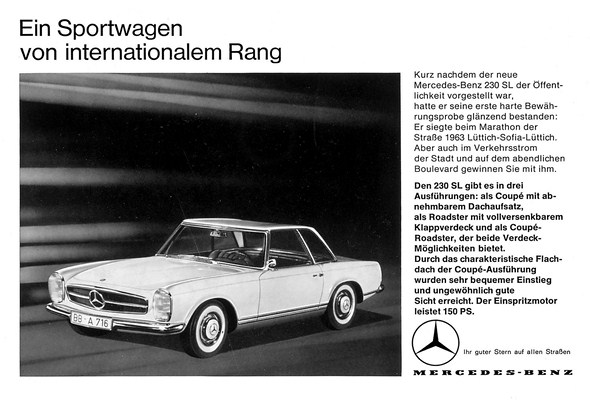
The “Pagoda” – sporting tradition with the SL from the model range W 113
- One car to replace two previous model ranges
- Advertising now with moving pictures
In March 1963 a new SL celebrated its premiere at the Geneva Motor Show. Mercedes-Benz presented one sports car to replace two previous models. The model 230 SL, known in-house as the W 113, took on a difficult legacy – partly because its two predecessors, models 300 SL (W 198) and 190 SL (W 121) had been very popular and successful from the very beginning, and partly because the two cars – despite their similarities – represented fundamentally different vehicle concepts.
The new model was designed to follow a middle course: the Mercedes-Benz 230 SL is neither an uncompromising roadster nor an extremely gentle-tempered boulevard sports car, but more a comfortable high-performance two-seater touring car with exemplary driving safety.
An advertising film produced by Armin Lang which lasted a bare fifteen minutes focused on the sporting tradition of the 230 SL. Karl Kling, the former Mercedes-Benz racing driver and later racing manager acted as test driver and was a little reminiscent of a radio commentator of years ago.
According to Kling, the Mercedes-Benz 230 SL combined “new, unconventional styling with mature engineering”. The pictures show him driving over various test tracks, changing direction quickly, making daring overtaking manoeuvres and slamming on his brakes. “Outstanding roadholding – achieved by separating wheel guidance and suspension, a long wheel base and a very wide track,” was how Kling described the SL and carried on enthusiastically, “Even driving round very sharp bends it has extremely good roadholding and only a slight tendency to roll.
” Although the very roomy boot and adjustable hot air blower were also mentioned, the Mercedes-Benz 230 SL was presented as a high-class sports car. Even the rear side of the seats fitted with ventilation slits had been “designed for sporty driving.
” It is therefore not surprising that at the end of the film the elegant 230 SL drives a lap around the Nürburgring and Karl Kling summed up, “This is a car for driving individualists for whom sportiness without a comfortable ride and exclusivity without worldwide service are simply not good enough. It is for those who expect one model to provide everything.”
Sporty handling and a comfortable ride
The first advertisements in print for the new Mercedes-Benz 230 SL also emphasised its sporty aspects and comfortable ride. A racing helmet and a bowler hat were symbolic for the new car. On another advertisement it was stated quite clearly that the car had “brilliantly stood its first hard test” by winning the long-distance race Liège-Sofia-Liège, but that one was also “a winner when driving through city traffic or along the boulevard in the evening”.
As well as pointing out the three roof types available – Coupé with detachable hardtop, Roadster with retractable soft top and Coupé-Roadster which offered both variants – under the headline “A sports car with international standing”, it praised the performance of the injection engine with its 110 kW (150 hp), the “very easy entry” as well as the “unusually good visibility”.
In another advertisement, the good visibility of the Mercedes-Benz 230 SL was picked out “from the multitude of good features” and mentioned as a “prerequisite for fast and sporty driving”. Due to the characteristic shape of the flat Coupé roof of the SL – which soon led to its nickname of “Pagoda” – the driver was able to “enjoy extremely good visibility in all directions with a wide angle for a good view upwards.”
The desire to be the best
In an advertisement in English, the angle of view for the observer is shown from above looking down. Here an appeal was made to those feelings experienced by riders on the back of a galloping horse: the longing for power, speed and rhythm and the desire to be the best (one-upmanship). All of this was also provided by the sports car with the huge star on its radiator grill. The Mercedes-Benz 230 SL combined power, quality and style.
A similar language is conveyed by another advertising motif showing a smartly dressed archer aiming at the target. The “Pagoda” SL is parked at the side of the road, his female companion is leaning casually against a tree in the background and the whole scene is set in a leaf-rustling autumn idyll. That is how Mercedes-Benz advertised its desire for perfection in 1964.
Safety, comfort, economic efficiency and the building of legends
During the 1950s and 1960s it was usual to include pictures of women in the advertisements. They were frequently shown as smiling co-drivers accompanying widely-travelled gentlemen going out for a spin – but also as a self-assured driver behind the steering wheel. Whereas male customers were supposed to be well-versed in the technical ins-and-outs of cars, the attention of the ladies was increasingly drawn to topics such as safety, comfort and economic efficiency.
Mercedes-Benz endeavoured to remove the fear of parking the car with the motif of a woman in a Mercedes-Benz 230 SL doing just that. According to the advert, the wide range of optional extras such as power steering and automatic transmission made it much more “enjoyable to drive a Mercedes-Benz” – and with the roof open even through the hubbub of a large town.
“Does it really pay to drive a sporty car nowadays?” was the question posed by a self-answering advertisement in 1965. The accompanying text explained that the safety features installed in the Mercedes-Benz 230 SL were greater than its speed and that it was “technically perfect (for men) and easy to drive (for women)”. A year later, without further ado, the advertisers declared the coveted 230 SL to be the “most sensible dream car in the world”.
A picture of a bright red 230 SL was clearly intended for a man’s world. Once you had been on a test drive with it, “you will have no peace of mind until you have bought it,” is the tenor of the text of an advertisement which also exists in French. Even if “people no longer turn round on the street to look at a car” – this didn’t apply to the 230 SL “as the car’s renown made it virtually a legend”.
Mercedes-Benz 250 SL and 280 SL
An open top roadster is standing in the bright summer sunshine in the middle of a field. Even before it was launched in 1967 to replace the 230 SL, Mercedes-Benz was advertising the new 250 SL. At that time the range of passenger cars supplied by the company from Stuttgart consisted of 15 models which were available “in 162 of the world’s 168 countries”.
The following year, the same motif was used again, this time with texts explaining the most important innovations in the 250 SL which had almost all been taken over from the Mercedes-Benz 250 SE: 2500 cc instead of 2300 cc, disc brakes on all four wheels and a larger fuel tank taking 82 litres. And by the way, “two of the most popular extras are the Mercedes-Benz automatic transmission and the power steering”.
“With the chassis and the engine of a sports car, but the comfort of a saloon” – this simple phrase was sufficient to describe the Mercedes-Benz 250 SL in one advertisement. In the accompanying picture, the car seems to approach at speed out of the top left corner, at the same time raising a lot of dust.
The text of the advertisement concluded with the information that the 250 SL completed the range of passenger cars offered by Mercedes-Benz in 1967 and that there would be no “further alterations […] this year despite any rumours to the contrary!”
The writers of the text were in the event proved right, but little more than a year after its first presentation the 250 SL was replaced on the market by the 280 SL. At the same time as the launch of the new medium-sized cars, the SL was also given a 15 kW (20 hp) stronger, 2800 cc engine.
Apart from the model plate, the 280 SL can only be distinguished from its two predecessors by its altered ornamental hub caps. The 280 SL had one of the rare advertising appearances together with the renowned Mercedes-Benz 300 SEL 6.3, a saloon with a performance similar to that of a sports car. “One is a sports car with the comfort of a saloon, the other a comfortable saloon performing like a sports car. Take your pick.” Car advertising can be so simple.
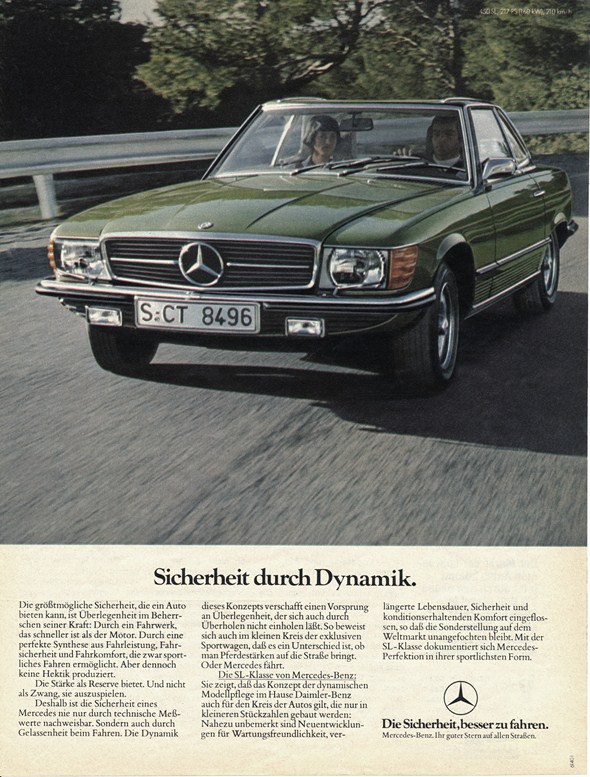
The Mercedes-Benz 350 SL (R 107): “A completely new sports car”
- Changing imagery: less of a race track atmosphere, more everyday situations
- The increasing importance of safety
“When a new Mercedes appears, it is a new car.” With these words, the 350 SL was rung out and the new SL product range rung in. “Anything else would surprise Mercedes drivers.”
And as a matter of fact, from an engineering point of view the new model, known in-house as the R 107, was a genuine new development having very little in common with the preceding model. Basic components were however already familiar from other Mercedes-Benz models: the front and rear suspension corresponded basically to the construction used for the “stroke eight” models and the V8 engine also did good service in the Saloons, Coupés and Cabriolets of the 280 SE 3.5 range.
The differences were a lot less conspicuous – even the 350 SL was a two-seater with a completely retractable roadster soft top and a detachable hardtop. The process of abandoning the idea of an uncompromising hard sports car – already initiated with the “Pagoda” SL – in the direction of a more comfortable, high-performance luxury two-seater was completed finally and unequivocally with the introduction of the new SL.
A change could also been seen in the imagery used for advertising. Less of a racing track atmosphere, more everyday situations was the new direction. In a one-minute advertising film the Mercedes-Benz 350 SL was shown driving along winding country roads, through dark tunnels, narrow tree-lined roads and narrow alleys in old town centres. With a closed soft top, the SL was able to demonstrate its superiority on the motorway by overtaking a small French car.
Everything seemed to be extremely easy; the relaxed music in the background reinforced the impression. The SL was even allowed to go on a short trip to the beach, small waves rolled onto the sand and the sun turned into a Mercedes star.
The increasing importance of safety
In addition to such pleasant everyday situations, the theme safety became one of the important aspects of the SL advertising. “One of the safest Gran Turismo cars in the world – and one of the most beautiful,” was the message communicated by an advertisement published in Switzerland. On it the 350 SL was shown three times: as an open top roadster, with a closed soft top and fitted with its hardtop.
Numerous innovative features which improved both the active and passive safety for the models 280 SL, 350 SL and 450 SL were introduced in a product information film lasting about four minutes which was made in 1975.
These features included newly developed wind deflectors on the front roof pillars which also served as rain channels to keep the side windows clean in inclement weather and large rear lamps with a ribbed surface profile moulded round the corners of the vehicle, the surface also making the lamps extremely insensitive to dirt. The test drive round the company’s own test track was also shown frequently as it emphasised the perfectly tuned chassis.
Additionally, the crumple zone and safer passenger compartment were explained, as were the advantages of having the fuel tank positioned over the rear axle. Also flickering over the screen were the new safety steering column and the steering wheel with impact absorber.
There is no doubt that technology designed to increase safety started to play an important role in advertising. An advertisement from 1976 was given the slogan “Safety through dynamics”. The accompanying text explained, “The greatest safety a car can offer comes from the superior control of its power: by having a chassis which responds faster than its engine.” However, the advertisement did not only refer to the mature engineering of the SL, it also brought up the need for “relaxed driving”.
At this time it was not only the SL that was promoted under the safety aspect. During the 1970s, the brand with the star developed various campaign slogans for models in general such as: “When one talks about Mercedes, one thinks about safety” (1971 to 1972) or “The safety to drive better” (1975 to 1976).
Women’s car and men’s pictures
Let’s go back to the moving pictures from 1975: the scene shows a lady in a yellow costume driving an SL through a multi-storey car park with a Dalmatian sitting on the co-driver’s seat making the vehicle’s potential as a woman’s car quite clear.
Without removing her gloved hands from the steering wheel, she reverses into a parking space. Her four-legged companion is overjoyed. Without further ado it jumps out of the cabriolet and runs after its mistress who is walking away.
While the ladies’ world was to get enthusiastic about the manoeuvrability and clear visibility of the SL, the man of the world was to follow his age-old instinct to look for adventure: at more than 200 km/h he speeds down the Autobahn, the spurt across the traffic lights is daring, the exemplary handling round bends is demonstrated on public roads.
The technical data was impressive: 147 kW (200 hp), from nought to 100 km/h in 8.8 seconds, top speed 210 km/h. “For speedy, controlled and fair driving.”
Twelve years later the classic gender role had almost disappeared from advertising. In an advertisement from 1987 a young couple was sitting together in a Mercedes-Benz 420 SL – admittedly the man was behind the wheel. “You still have an experience awaiting you: Mercedes SL.” This easy to understand message was used to promote open top driving in the models 300 SL, 420 SL and 500 SL.
Mercedes drivers and prejudices
One rather strange or bizarre advertising gag in 1971 was a list of six popular prejudices in connection with Mercedes drivers which were printed in an extra box on a 350 SL advertisement. The list ranged from “stick-in-the-mud” and “absolutely unsporting” to “terribly materialistic”. Among them also stood, both invitingly and hopeful: “Mercedes drivers put up with these prejudices. They know exactly what they want. And you certainly know it as well.”
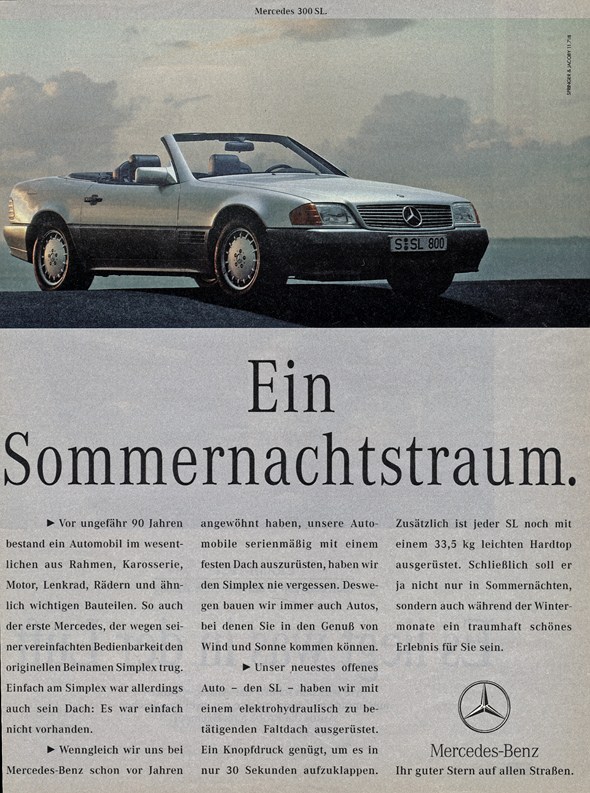
The legend lives – the SL from the R 129 model series
- A car full of modern technology
- Folding top with electric controls and automatic roll bar
- Perfect design
The next generation of the SL, known in-house as the R 129, was one of the main attractions at the Geneva Car Show in March, 1989. The new SL was absolutely full of new technology resulting in remarkable improvements especially in connection with passive safety.
However, at first the advertisers did not prepare the launch by pointing out the technical innovations, but by looking back at the history of the product range. To set the stage, the legendary gull wing model from 1954 was sent onto the field.
“What else happened in 1954 apart from the football World Cup,” asked the new house agency Springer & Jacoby in their advertisement showing the classic 300 SL with open gull wing doors and it carried on in the accompanying text, “Nowadays, when we want to design a new car at Mercedes-Benz, we set our standards on a legend like the 300 SL.”
The Mercedes advertisers then made the connection between 1954 and the present day by using a multitude of other motifs. “The beginning of a legend” – these five words sufficed to describe a double-page spread of a silver Mercedes-Benz 300 SL car from 1954.
On turning over to the next two pages, the reader found the image of a new 500 SL car pictured with the identical composition accompanied by two concise statements: “The legend lives. The new SL” According to the text of the advertisement, tradition and innovation belong “together in a unique way in a Mercedes-Benz car”. Specific examples of forward-looking technology were given, including, among others, “engines designed with four valves per cylinder and an electronically mapped intake camshaft” as well as a “chassis with a fully automatic, adaptive damping system and speed-sensitive level control”.
In the United States both racing and series versions of the gull wing car were used to gain approval for the new SL model. In between the historical black-and-white shots, the messages read: “The immortals drove it.”; “The world acclaimed it.”; “The collectors prized it.”; – “Now, one car surpasses it.”
The language of the campaign in Germany was much more down-to-earth. The studio portrait of the silver 500 SL model already used the previous year was used for an advertisement in 1990 titled, “Leading star for a new dimension of quality in sportiness”. The new SL received an attest for “performance, safety and comfort of an extremely high and unique level” and it was elected to be “the shining example of a new perception of sportiness”. There could hardly have been more understatement.
However, it got even duller. The three “Autovision” TV commercials in 1989 presenting the topics performance, safety and comfort described the technical refinements of the new SL in such a way that the tone could hardly have been more serious.
“Where is the car going? Is it always about better performance? – Or shouldn’t we rather face the conflicting targets of deciding between performance, safety, comfort and the environment?” asked the narrator – and received the appropriate answers dictated into the microphone by the current Mercedes-Benz experts of the time.
Folding top with electric controls and automatic roll bar
The creative experts at Springer & Jacoby showed that it could be done differently. With a large-sized advertisement stating “How lovely, there is no roll bar – but how good that it has got one” it was possible to take up the topic of safety and accompany it with a wink.
The SL was “a car that was often called a ‘technical miracle’ and ‘super sports car’ by the general public” – and that was partly due to the “roll bar that you only see if you need it.” The automatic roll bar helped the passengers to survive if the car should happen to overturn. However, to avoid spoiling the joy of motoring with an open top by having a fixed roll bar, for the first time the SL was given a version which shot upwards within only 0.3 seconds when it was needed.
Advertising can be so simple. In the United Kingdom it only took a series of three photos taken of the crash test and the German word “Wunderbar” to promote the safety of the SL. Of course, in the descriptive text to go with the photos the automatic roll bar was also mentioned – and at the same time the safety of the newly introduced Mercedes-Benz C-Class was given due praise.
A summer night’s dream – even during the winter months
The automatic roll bar appeared in the advertising for the SL again and again – even in an advertisement using the winning of the “Car Design Award” in Turin as its theme. “Mercedes wins Turin Grand Prix with a series production car”. The photo shows only the cut-off front of a wine-red SL – with the large star on its radiator grill.
“A summer night’s dream” was the title of an advertisement in 1991 showing an open Mercedes-Benz 300 SL at the coast. When looking at this photograph it is quite clear: the fact that the roll bar is invisible has aesthetic reasons. Especially when open the SL was a dream car.
It took only 30 seconds to open the folding soft top – and there was only one button to be pressed. The text below described the standard hardtop and maintained that with it the SL was “like being in a dream, not just during summer nights, but also in the winter months”.
The beauty of the car – that was the only topic in an advertisement that appeared in the United States at the beginning of the 1990s. The interplay of light and shade, the contours of the long-drawn bonnet and the shining star – although only a little more than a third of the vehicle is shown, the SL can be recognised immediately. The two-seater as a work of art – that is how this advertisement sees itself. “Most of the great works of art follow classic forms. And just a few create them.”
An advertisement from the USA in 1993 is a successful creation combining an artistic studio photograph and a clever advertising idea. Instead of a striking headline, under the photograph of the red SL taken from the side there is simply a heartbeat diagram set in inverted commas.
“Your pulse accelerates when you approach the Mercedes-Benz 500 SL Roadster,” is how the text covering several columns begins, and it then goes on to describe every second that passes until the ignition key is turned.
Technology transfer does not only go in one direction
Way back in history, a two-page advertisement comparing the 1989 Sauber-Mercedes C11 saloon racing car with the 1952 300 SL racing sports car (W 194) carried a headline, “It’s just as well we haven’t forgotten anything.” In the very detailed text below the writer theorises about technology transfer from motorsport to series production.
“There has always been a great deal of fierce discussion about the value of motorsport and car manufacturers say that they need the experience gained in motorsport for the series production. In short, they build such good series production cars because they build such good racing cars.” But at Mercedes-Benz, it says, this could work “just as well the other way round”.
Especially in Affalterbach near Stuttgart, building racing cars and series production cars get very close to each other. Since 1990 there has been a co-operation agreement between AMG and the Daimler-Benz AG. From 1 January 1999, with a share of 51%, AMG became a subsidiary of the DaimlerChrysler AG at that time and was given the name Mercedes-AMG GmbH.
When the first vehicles developed on the basis of the co-operation agreement came on the market in 1993, it was first of all the SL-Class model SL 60 AMG (6000 cc, V8, 280 kW (381 hp) which was available until 1998). It was followed by the models SL 55 AMG (5500 cc, V8, 260 kW (354 hp), built from 1999 to 2001) as well as the top model with a twelve cylinder engine, the SL 73 AMG (7300 cc, V12, 386 kW (525 hp), built from 1999 to 2001).
A new SL for the 21st century: R 230 model series
- Into the future of open top driving with the Vario roof
- TV commercial: “Sport as never before”
The world premiere of the first model in the next SL model series, the Mercedes-Benz SL 500, known in-house as R 230, was celebrated in the Hamburg Deichtorhalle in July 2001. Here Mercedes-Benz was writing a new chapter in the history of the SL product ranges.
Unlike all its predecessors, this SL could carry its hardtop with it all the time. The roof, known as the Vario roof, could open or shut within 16 seconds just by pressing a button. The striking design details of this new SL united tradition and future.
For instance, the air vents in the front wings took up a typical feature of the 300 SL from the 1950s. Also the narrow, wing-like profile on these side vents – called “fins” by the experts – is reminiscent of the legendary sports car.
“Driving it could put a strain on your heart. Never being able to drive it could break it.” It is easy to recognise that Springer & Jacobi were the agency responsible for the campaign by the slightly ironic tone of this large-sized advertisement produced for the launch of the new SL.
By promising “Sport as never before” attention is drawn to the Vario roof that opens in world record time. As parenthesis only a rhetorical question was needed – including the answer. “Do we have to say any more? The new SL will move you – even if it is standing still.”
The short, 45-second commercial televised in 2001 wanted to appeal to emotions. The black-and-white film first showed cheering fans and their tense faces and then put the question, “How do the drivers feel if fans feel like this?”
The answer is given by showing shots of the new SL driving along and the prospect of enjoying “Sport as never before” with the SL. “With SBC, ABC and ESP” – because of course even an SL can’t do without state-of-the-art safety features.
As part of the facelift in spring 2008, the SL 63 AMG was launched. “Air resistance futile” warned the relevant advertisement showing an SL conspicuously adorned with a lot of decorations from the world of motor racing.
For and with classic SL models: maintaining the legend
- Every SL is a classic
- Advertising with historical vehicles
A legend cannot be created artificially; it comes into being on its own. During the course of the decades, the historical SL models – first and foremost the world famous gull wing model – have become automotive legends. The fascination for these vehicles affects car enthusiasts all over the world. It is hardly surprising therefore that Mercedes-Benz also uses the potential of these classic vehicles for various kinds of advertising.
“Mille grazie, Mille Miglia.” In 1997 the Mille Miglia, a legendary Italian long distance race from Brescia to Rome and back, celebrated its 70th anniversary. Mercedes-Benz was also there and bought a full-page advertisement for the successful 300 SL racing sports car (W 194) from 1952.
It doesn’t stand anywhere that nowadays the race is not about top speeds, but about steady driving. And why should it? The “Veni, vidi, vici!” in small print over the sunny photograph really passes on the motorsport legend much better.
A good example of combined advertising with historical and current models is the advertisement from 1994. “In those days you were a bit too young” stands over the picture of a 300 SL Roadster from 1957. Underneath it is the photograph of what was the then current SL model, product range R 129, accompanied by the good advice, “Don’t wait until you are too old.” The clear message comes across: now or never.
In an advertisement published three years later, the models are driving in opposite directions. This time the current SL is depicted over the classic version. “There are alternatives to a new SL,” is the propaganda being spread around, and in the next line this is interestingly stated much more precisely “About 1200 units”
. Those who read the text of the advertisement learn that there were “never more than 1858 units worldwide” of the 300 SL Roadster (W 198 II) and that nowadays it should prove rather difficult to get hold of – but the reader should console himself with the thought “that the current SL is much more comfortable and is part of a much bigger production run than its predecessor.”
The silver 300 SL Roadster model with its red interior fittings is standing in dark studio surroundings. It only took a few words in 2007 to communicate the message of an advertisement published in Austria: “In 1957 it really paid to invest in silver.” The star, the Mercedes-Benz lettering and the internet address were supported by one more sentence in small print: “For decades a dream of luxury”.
A 198 725 0223, A 198 725 0123 or A 198 766 0126 – with these numbers it is still possible today to find the right original parts for a Mercedes-Benz 300 SL from the 1950s. And at Mercedes-Benz the classic car with gull wings is still “also available on request in individual parts” – at least that is what an advertisement promised in 2010.
Not only Mercedes-Benz creates advertising with classic SL models. Other companies also use the unique charisma of the coveted car for themselves and their products. “What only a few people used to have, everybody can have today”. Bosch used this claim in 1999 in a two-page advertisement for petrol-direct injection, which was “originally reserved for top class vehicles only”.
In the photograph two boys are talking shop in front of a 300 SL with an open gull wing door. As early as 1988 the car care specialist Sonax had two dogs posed in an advertisement with a Mercedes-Benz 300 SL Roadster. While their owner was washing his valuable car the long-haired dogs shook themselves photogenically and were snapped at just the right moment.

